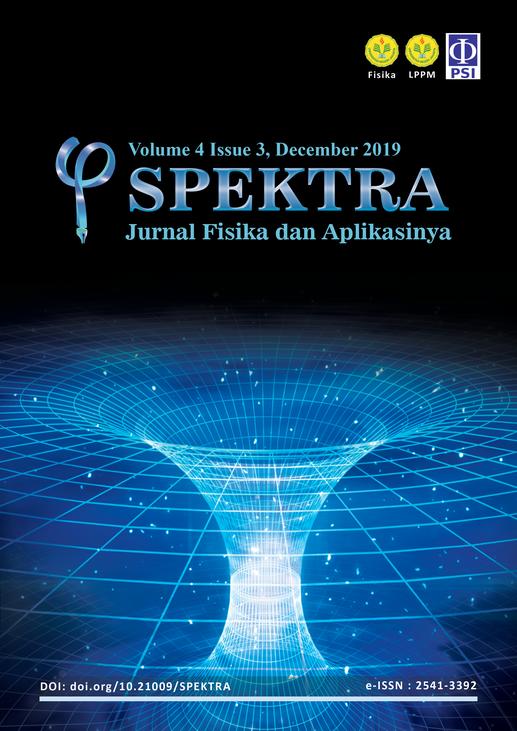ANALYSIS OF STRUCTURE AND ANTIMICROBIAL ACTIVITY OF CeO2 AND Nd2O3 NANOPARTICLES
DOI:
https://doi.org/10.21009/SPEKTRA.043.01Keywords:
CeO2, Nd2O3, face-centered cubic, hexagonal, anti-microbeAbstract
Cerium oxide (CeO2) and Neodymium oxide (Nd2O3) nanoparticles using local content have been synthesized by precipitation method. The CeO2 and Nd2O3 nanoparticles were characterized by X-Ray Diffraction (XRD) and Fourier Transform Infrared (FTIR) to analyze the material phase and structure. The XRD spectrum shows that CeO2 and Nd2O3 nanoparticles have face-centered cubic and hexagonal, and cubic, respectively. The anti-microbial activity of CeO2 and Nd2O3 nanoparticles was analyzed by diffusion method using gram-negative bacteria (E. coli, S. aureus, P. aeruginosa), and gram-positive bacteria (S. entericatyphi, L. monocyogenes), and fungus (C. albicans). The result confirms that CeO2 and Nd2O3 nanoparticles have the capability of microbial pathogen inhibition. The CeO2 nanoparticles have the effective activities of inhibition for the microbial of S. aureus and S. entericatyphi, whereas Nd2O3 nanoparticles can inhibit the microbial of P. aeruginosa, S. entericatyphi, and L. monocyogenes.
References
[2] R. Nuryadi and R.D. Mayasari, “ZnO/Au-based surface plasmon resonance for CO2 gas sensing application”, Applied Physics A Materials Science & Processing, Springer Berlin Heidelberg, 122: 13, 2015.
[3] Q. Zhang, E. Uchaker, S.L. Candelaria, and G. Cao, “Nanomaterials for energy conversion and storage”, Chemical Society Reviews, Vol. 42, 2013, pp. 3127-3171.
[4] I. A. Passos Farias, C. C. Lima dos Santos, R. C. Sampaio, “Antimicrobial activity of cerium oxide nanoparticles on opportunistic microorganism : a systematic review”, Hindawi, BioMed Research International, Article ID 1923606, 2018, pp. 1-14.
[5] I. Setiawan, “Toward the challenging REE exploration in Indonesia”, IOP Conf. Series: Earth and Environmental Science, Vol. 118, 2018, pp. 1-5.
[6] S. Parvathya and B.R. Venkatramanb, “Invitro antibacterial and anticancer potential of CeO2 nanoparticles prepared by co-precipitation and green synthesis method”, Journal of Nanosciences: Current Research, Vol. 2, Issue 2, 2017, pp. 1-9.
[7] K.M. Kumar, M. Mahendhiran, M.C. Diaz, N.H. Como, A.H. Eligio, G.T. Torres, S. Godavarthi, and L.M., Gomez, “Green synthesis of Ce3+ rich CeO2 nanoparticles and its antimicrobial studies”, Materials Letters, Vol. 214, 2018, pp. 15-19.
[8] R. Yuvakkumar and S.I. Hong, “Nd2O3: novel synthesis and characterization, Journal of Sol-Gel Science and Technology, Vol. 73, 2015, pp. 511-517.
[9] S. Alghool, M.S. Zoromba, and H.F.A. El-Halim, “Lanthanide amino acid Schiff base complexes: synthesis, spectroscopic characterization, physical properties and in vitro antimicrobial studies”, Journal of Rare Earths, Vol. 31, No. 7, 2013, pp. 715-720.
[10] M. Farahmandjou and M. Zarinkamar, “Synthesis of nano-sized ceria (CeO2) particles via a cerium hydroxy carbonate precursor and the effect of reaction temperature on particle morphology”, Journal of Ultrafine Grained and Nanostructured Materials, Vol.48, No.1, 2015, pp. 5-10.
[11] Y.A. Syed Khadar, A. Balamuruganb, V.P. Devarajana, R. Subramanianc, and S. Dinesh Kumar, “Synthesis, characterization and antibacterial activity of cobalt doped cerium oxide (CeO2:Co) nanoparticles by using hydrothermal method”, Journal of Materials Research and Technology, Vo. 8, No. 1, 2019, pp. 267-274.
[12] L.P. Babenko, N.M. Zholobak, A.B. Shcherbakov, S.I. Voychuk, L.M. Lazarenko, and M.Y. Spivak, “Antibacterial activity of cerium colloids against opportunistic microorganisms in vitro”, Mikrobiolohichnyi zhurnal (Kiev, Ukraine : 1993), Vol. 74, No. 3, 2012, pp. 54-62.
[13] L.S. Reddy Yadav, K. Manjunath, B. Archana, “Fruit juice extract mediated synthesis of CeO2 nanoparticles for antibacterial and photocatalytic activities,” The European Physical Journal Plus, Vol. 131, No. 5, 2016.
[14] J. Malleshappa, H. Nagabhushans, S.C. Sharma, Y.S. Vidya, K.S. Anantharaju, S.C. Prashantha, B.D. Prasad, H.R. Naika, K. Lingaraju, and B.S. Surendra, “Leucas aspera mediated multifuctional CeO2 nanoparticles: structural, photoluminescent, photocatalytic and antibacterial properties”, Spectrochimica Acta part A : Molecular and Biomolecular Spectroscopy, Vol. 49, 2015, pp. 452-462.
[15] T. N. Ravishankar, T. Ramakrisshappa, G. Nagaraju, and H. Rajanaika, “Synthesis and characterization of CeO2 nanoparticles via solution combustion method for photocatalytic and antibacterial activity studies”, Chemistry Open, Vol 4, No. 2, 2015, pp. 146-154.
Downloads
Published
How to Cite
Issue
Section
License
SPEKTRA: Jurnal Fisika dan Aplikasinya allow the author(s) to hold the copyright without restrictions and allow the author(s) to retain publishing rights without restrictions. SPEKTRA: Jurnal Fisika dan Aplikasinya CC-BY or an equivalent license as the optimal license for the publication, distribution, use, and reuse of scholarly work. In developing strategy and setting priorities, SPEKTRA: Jurnal Fisika dan Aplikasinya recognize that free access is better than priced access, libre access is better than free access, and libre under CC-BY or the equivalent is better than libre under more restrictive open licenses. We should achieve what we can when we can. We should not delay achieving free in order to achieve libre, and we should not stop with free when we can achieve libre.
 SPEKTRA: Jurnal Fisika dan Aplikasinya is licensed under a Creative Commons Attribution 4.0 International License.
SPEKTRA: Jurnal Fisika dan Aplikasinya is licensed under a Creative Commons Attribution 4.0 International License.
You are free to:
Share - copy and redistribute the material in any medium or format
Adapt - remix, transform, and build upon the material for any purpose, even commercially.
The licensor cannot revoke these freedoms as long as you follow the license terms.

 E-ISSN 2541-3392
E-ISSN 2541-3392  Focus & Scope
Focus & Scope  Editorial Team
Editorial Team  Reviewer Team
Reviewer Team  Author Guidelines
Author Guidelines  Article Template
Article Template  Author Fee
Author Fee  Publication Ethics
Publication Ethics  Plagiarism Policy
Plagiarism Policy  Open Access Policy
Open Access Policy  Peer Review Process
Peer Review Process  Retraction & Correction
Retraction & Correction  Licensing & Copyright
Licensing & Copyright  Archiving & Repository
Archiving & Repository  Contact
Contact  Mendeley
Mendeley 

